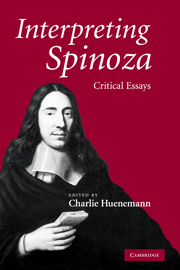Book contents
- Frontmatter
- Contents
- Notes on contributors
- Method of citation
- Introduction
- Chapter 1 Representation and consciousness in Spinoza's naturalistic theory of the imagination
- Chapter 2 Rationalism run amok: representation and the reality of emotions in Spinoza
- Chapter 3 “Whatever is, is in God”: substance and things in Spinoza's metaphysics
- Chapter 4 Necessitarianism in Spinoza and Leibniz
- Chapter 5 Epistemic autonomy in Spinoza
- Chapter 6 Spinoza and the philosophy of history
- Chapter 7 Democracy and the good life in Spinoza's philosophy
- Chapter 8 Spinoza's unstable politics of freedom
- Chapter 9 Should Spinoza have published his philosophy?
- Bibliography
- Index
Chapter 2 - Rationalism run amok: representation and the reality of emotions in Spinoza
Published online by Cambridge University Press: 22 September 2009
- Frontmatter
- Contents
- Notes on contributors
- Method of citation
- Introduction
- Chapter 1 Representation and consciousness in Spinoza's naturalistic theory of the imagination
- Chapter 2 Rationalism run amok: representation and the reality of emotions in Spinoza
- Chapter 3 “Whatever is, is in God”: substance and things in Spinoza's metaphysics
- Chapter 4 Necessitarianism in Spinoza and Leibniz
- Chapter 5 Epistemic autonomy in Spinoza
- Chapter 6 Spinoza and the philosophy of history
- Chapter 7 Democracy and the good life in Spinoza's philosophy
- Chapter 8 Spinoza's unstable politics of freedom
- Chapter 9 Should Spinoza have published his philosophy?
- Bibliography
- Index
Summary
Everytime we say goodbye,
I die a little.
Cole PorterConsider two different dimensions along which a rationalist account of the emotions might develop.
According to the first dimension, emotions are themselves expressions of reason; they are, or at least can be, a rational, reasoned response to a state of affairs. I will (vaguely) describe this (vague) rationalist view as the view that emotions are inherently rational.
According to the second dimension of a rationalist account of the emotions, emotions – though they may be in some measure rational, even inherently rational – are somehow inferior to the unfettered operation of reason. Perhaps, on this view, emotions cloud our judgment and lead us to misapprehend the truth and to act in ways that are – in one way or another – contrary to reason. I will (vaguely) describe this (vague) rationalist view as the view that emotions are inferior to reason.
These two rationalist dimensions are, of course, not exhaustive: there are, perhaps, many other ways to articulate a rationalist approach to the emotions. Further, these two dimensions are compatible: one can hold that the emotions are inherently rational, but not perfectly so and that other, more purely rational, responses to a given situation are somehow superior. Finally, these views are independent in that one can hold one view without holding the other.
I won't attempt to pin either of these rationalist views (or their denials) on particular philosophers, other than Spinoza. That can only get me into trouble.
- Type
- Chapter
- Information
- Interpreting SpinozaCritical Essays, pp. 26 - 52Publisher: Cambridge University PressPrint publication year: 2008
- 5
- Cited by

